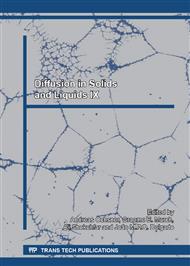[1]
M. Rabello: Aditivação de Polímeros. Edited by Artliber, SP (2007).
Google Scholar
[2]
Information on: http://www.plastivida.org.br/2009/Noticias_2012_058.aspx.
Google Scholar
[3]
Information on: http://file.abiplast.org.br/download/perfil_2011.pdf.
Google Scholar
[4]
Information on: http://www.adirplast.com.br/adirplast-estatisticas.html.
Google Scholar
[5]
C. Pigatto. Polipropileno e Blendas PP/EPDM Reforçadas com Fibras Curtas de Sisal. Academic Publishers (2009).
Google Scholar
[6]
F.C. Ruiz and M.C. Terence. Estudo das Propriedades de Blendas de Polipropileno e Polietileno Submetidos à Radiação Gama. Porto de Galinhas – PE, Brazil. 18° CBECiMat, 24 a 28 de nov. 2008.
DOI: 10.47749/t/unicamp.1991.34942
Google Scholar
[7]
F. Rosário, et al. São Paulo: Resíduos de Sisal como Reforço em Compósitos de Propileno Virgem e Reciclado. Polímeros, vol. 21, n. 2, pp.90-97, Epub Apr 29, 2011.
DOI: 10.1590/s0104-14282011005000021
Google Scholar
[8]
X. Zhou and J. N. Hay. Structure-property relationships in annealed blends of linear low density polyethylene with isotactic polypropylene. United Kingdom: Butterworth-Heinemann. Polymer, Vol. 34 No 22, pp.4710-4716, 1993.
DOI: 10.1016/0032-3861(93)90706-g
Google Scholar
[9]
H. Wiebeck and J. Harada. Plásticos de Engenharia: Tecnologia e Aplicações. São Paulo: Artliber, p.19, pp.37-49, pp.163-168, 2005.
Google Scholar
[10]
S. Jose, A.S. Aprem, B. Francis, M.C. Chandy, P. Werner, V. Alstaedt and S. Thomas. Phase morphology, crystallization behavior and mechanical properties of isotactic polypropylene/high density polyethylene blends. India/Germany: Elsevier Science. European Polymer Journal, Vol. 40, No 9, pp.2105-2115, 2004.
DOI: 10.1016/j.eurpolymj.2004.02.026
Google Scholar
[11]
E.L. Rossini. Obtenção da Blenda Polimérica PET/PP/PE/EVA a Partir de "Garrafas PET" e Estudo das Modificações Provocadas pela Radiação Ionizante. Academic Publishers (2005).
Google Scholar
[12]
M.M. Hassan, N.A. El-Kelesh and A.M. Dessouki. The effect of gamma and electron beam irradiation on the thermal and mechanical properties of injection-moulded high crystallinity poly(propylene). Cairo – Egypt: Society of plastics engineers. Polymer Composites, Vol. 29, No 8, pp.883-889, 2008.
DOI: 10.1002/pc.20464
Google Scholar
[13]
Standard Test Method for Tensile Properties of Plastics.
Google Scholar
[14]
B.B. Neto, I.S. Scarminio and R.E. Bruns. Como fazer experimentos: pesquisa e desenvolvimento na ciência e na indústria. Campinas, SP: 2ª edtied by Unicamp, pp.201-216, 2003.
Google Scholar
[15]
H.B. Thorat, C.S. Prabhu, S. Kumar and M.V. Pandya. g-Ray-induced degradation in ethylene-propylene copolymer. India: John Wiley & Sons. Journal of Applied Polymer Science, Vol. 59, pp.1769-1773, 1996.
DOI: 10.1002/(sici)1097-4628(19960314)59:11<1769::aid-app13>3.0.co;2-p
Google Scholar
[16]
F.C. Ruiz and M.C. Terence. Efeito da radiação gama na blenda de polipropileno e polietileno destinada à produção de artigos obtidos por processo de termoformagem, moldagem por injeção e moldagem por sopro. Academic Publishers (2009).
DOI: 10.47749/t/unicamp.2007.399376
Google Scholar


